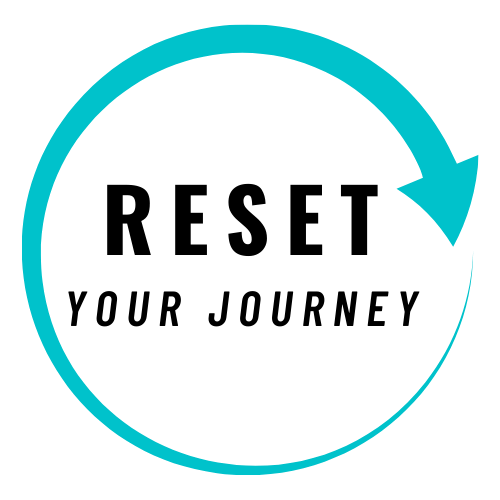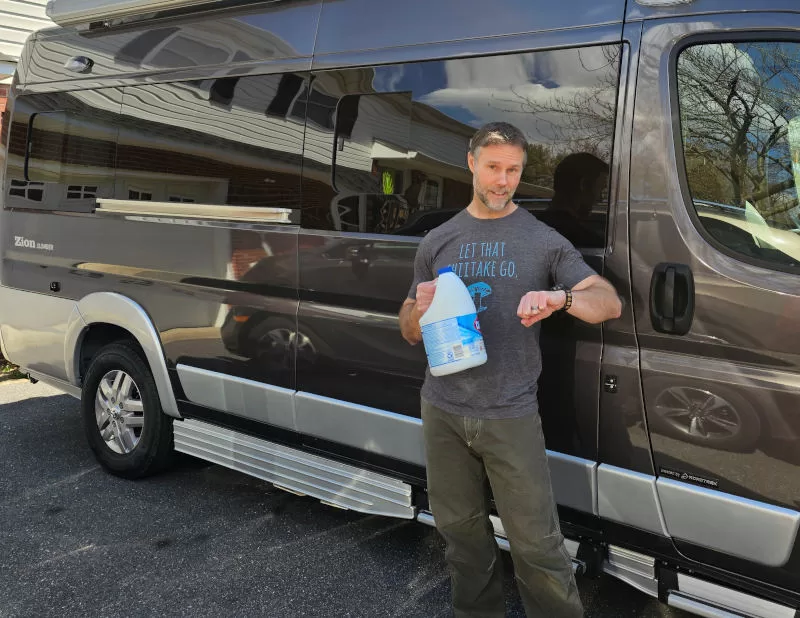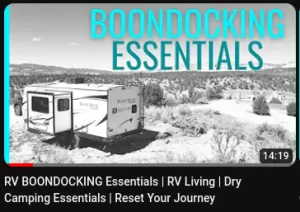Last Updated on 05/05/2024 by Glynn Willard
How Long To Leave Bleach In RV Water Tank?
The amount of time you leave bleach in the freshwater tank depends on the ppm concentration.
Fifty ppm should remain in the tank for 3-4 hours and 100 ppm for 30 minutes.
During my seven years studying Nutritional Physiology at the University of Delaware, I covered a lot of chemistry and biochemistry.
So I figured, why not turn to the research to see how long one should leave bleach in the RV’s fresh water system and the reasoning for the protocol.
I reviewed the research publications and several reputable RV manufacturing companies’ RV manuals to help you follow the most informed protocol.
We know what it’s like to consume contaminated water. During our full-time RV life, we encountered bad water once and suffered for a week.
And that’s the last thing your want!
With that said, no one is exempt from sanitizing their freshwater holding tank.
It should be made a part of everyone’s routine maintenance on their RV.
All RV owners need safe potable water during their travels, period.
Let’s dive into some bleached water and determine just how long to leave bleach in your RV’s plumbing system.
What Type Of Bleach For RV Fresh Water Tank?
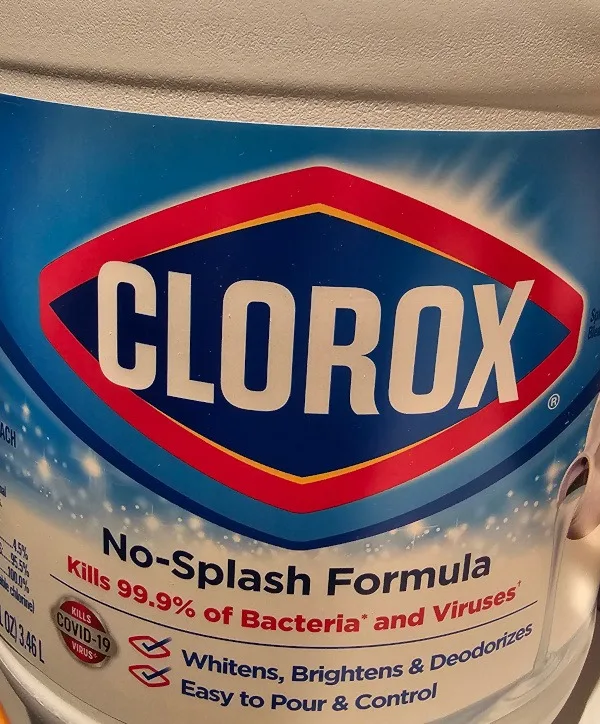
There’s no need for an industrial-grade bleach (aka, sodium hypochlorite) for your RV.
Household bleach acquired at the grocery store will do the job just fine.
A nationally recognized brand like Clorox or a store brand will yield the results you’re looking for.
Check the label and ensure it’s at least 4% sodium hypochlorite. Chances are, it’s between 4 and 8%.
Anything stronger and it will be too caustic on your RV’s water system.
The important point: make sure it does not contain any additional fragrances.
Understanding The Concentration Of Bleach Water
PPM or parts per million is just a way of describing the concentration of a substance in a solution.
When we describe a percentage, it’s out of 100.
But when we describe ppm, it’s out of a million, i.e., we’re discussing a very diluted substance.
In reference to the bleach in your freshwater tank and plumbing system, we’ll look at the approximate ppm of bleach per gallon of solution.
- 1 teaspoon 5.25% bleach in 1 gallon of water yields 65 ppm.
- 1 Tablespoon 5.25% bleach in 1 gallon of water yields 200 ppm.
- 1/4 cup 5.25% bleach in 1 gallon of water yields 800 ppm.
- 1 cup of bleach in 1 gallon of water yields 3200 ppm.
A 100 ppm concentration of bleach in water has been shown to kill all pathogens within thirty minutes.
So there’s no reason to exceed higher concentrations.
Let’s do some math!
If you add 1/2 Tablespoon per gallon times the total gallons of water tank capacity, you’ll reach 100 ppm for your freshwater system.
For example, if you have a 50-gallon tank, you would add 1.6 cups of bleach for thirty minutes.
But that’s overkill and will result in a chlorine smell that’s too strong.
This can be overcome by using less bleach for a longer duration.
So, let’s look at the appropriate chlorine solution first.
But before I go on, check out this nifty calculator that quantifies ppm for the concentration of bleach you’re using.
Amount Of Bleach For The Gallons Of Tank Capacity In Your RV
Based on what we learned above, 100 ppm will do the job in thirty minutes.
But we can acquire the same results with 50-60ppm with a longer wait time.
I won’t go into detail since I outlined the sanitizing procedure for RV freshwater tanks in my article: Easy Way To Sanitize Your RV’s Fresh Water Tank
Just understand that every component within your RV’s entire system needs to be exposed to the chlorine solution, including:
- The water pump.
- Hot water tank or tankless hot water heater. Note: this varies based on the manufacturer.
- All hot and cold water lines.
- I also run a little bleach through the fresh water hose on occasion.
- With the filters removed, your in-line water filter.
- And of course the freshwater tank.
Getting To The Point: How Long To Leave Bleach Mixture In Water Tank?
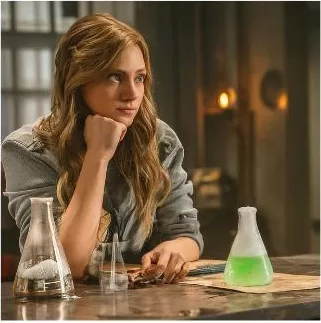
I realize some of the literature I’m referencing refers to sanitizing water for human consumption, not cleaning tanks.
However, the literature covering tank sanitization came relatively close to the same numbers for sanitizing food-grade equipment.
Therefore, I’m comfortable stating that the wait time if the number of gallons of bleach solution is:
- 13-26 ppm = 12-24 hours in the tank
- 50-60 ppm = 3-4 hours in the tank
- 100 ppm or higher = 30 minutes in the tank.
If you use our example above of the 50-gallon freshwater tank, but don’t want to be overwhelmed by a high concentration sanitizing solution, then:
- Add approximately 2/3 cup bleach for 4 hours.
- Flush the tank a couple of times and the smell should be gone.
Finding A Clean Water Source For Your RV
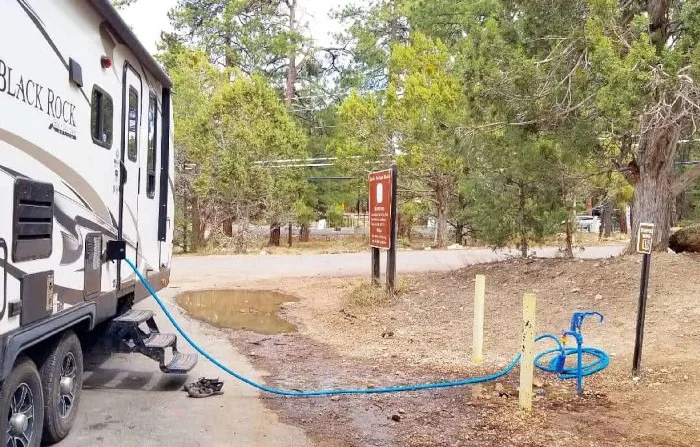
Many apps can point you to a water supply for your RV. We prefer to use iOverlander at the current time, but alternative options are surfacing.
Regardless, the point I want to specify is how to find a clean and safe water source.
It goes without saying that if you drink from your fresh tank, safe water is paramount.
For the most part, just about every place we found water during our two years of full-time, it was safe.
The least safe place to acquire potable water is:
- An RV dump station. Especially if the hose bib is close to the septic area.
The safest locations to acquire potable water (well water or from the municipal water systems):
- A reputable RV park.
- Clean rest areas.
- National Parks (my favorite).
- Truck stops.
- Boondockers Welcome if they offer water.
What If You Unintentionally Filled Your Freshwater Tank With Contaminated Water?
This applies if you still need to drink the contaminated water.
First step, use your emergency supply that you keep in your RV or tow vehicle.
Then add 1/8 of a teaspoon of bleach/gallon of water in your tank.
For a 100-gallon tank, that’s 0.125*100=12.5 teaspoons or 1/4 cup for 100 gallons of water.
If you have a dropper, then 8 drops per gallon of water.
Err on the side of caution with the amounts since you don’t know how full your tank really is.
The final step, let it sit for at least thirty minutes.
When in doubt about how full your tank is, use a little less bleach and allow it to sit longer.
There will still be a faint smell of chlorine, but the water is now safe to drink.
Keep in mind, that municipal water systems are treated with sodium hypochlorite to 2 ppm.
Yes, that’s four times less than the above example, but municipal water sits longer.
Not Sure What You Need For Your RV?
Best Way To Sanitize Your Emergency Jerry Can
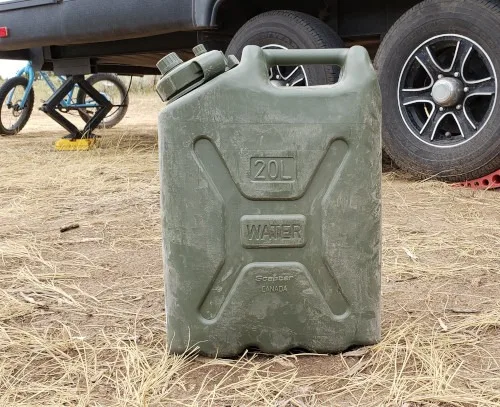
I mentioned earlier the importance of carrying spare water for emergencies.
If your freshwater tank runs dry while you’re boondocking or if you take on contaminated water, a full Jerry Can be your saving grace.
But you still have to cycle the water you have stored and sanitize the Jerry Can on occasion.
The steps are easy.
- Empty the Jerry Can
- Fill halfway with water.
- Add 1 teaspoon of unscented bleach to the can.
- Shake for 30 seconds.
- Dump the water and refill all the way with rinse water.
Dump the rinse water and refill with the water you’re storing.
If the smell of chlorine still resides in the Jerry Can, repeat the rinse cycle until the bleach smell is gone.
An Interesting Research Article On RV Tank Sanitization
A study examining a sample size of 20 RV owners published in 2013 noted that only 60% of them cleaned their freshwater tank within the last 12 months.
Of the 60% who claimed they cleaned their tanks, only one used bleach.
I agree, this sample size barely represents the entire population of RV owners.
But it does go to show that not everyone properly maintains their freshwater plumbing system in their RV.
Fortunately, the message of sanitizing your freshwater tank is far more pervasive now than in 2013.
I just found that tidbit interesting.
Wrapping Up Bleach For Your RV Water System
When in doubt, leave it in your tank a little longer.
When I bought my first travel trailer with an 80 gallon tank, I added 2 cups of bleach and let it sit overnight after running it through the system.
It was total overkill, but it worked fine.
What I’m trying to get at with this whole article is:
If you don’t feel like measuring everything, add what you think is right, let it sit over night and you’ll be successful in the mission.
How long do you leave bleach in your freshwater tank?
References
Janick F. Artiola, Ph.D., Channah Rock, Ph.D., and Gary Hix, RG, “Water Storage Tank Disinfection, Testing, and Maintenance,” College of Agriculture and Life Sciences, University of Arizona (Tucson, AZ)
Christine M. Litwin, Bankole Asebiomo, Katherine Wilson, Michael Hafez, Valerie Stevens, Carl B. Fliermans, Barry S. Fields, John F. Fisher, “Recreational Vehicle Water Tanks as a Possible Source for Legionella Infections”, Case Reports in Infectious Diseases, vol. 2013, Article ID 286347, 3 pages, 2013.
McGlynn, William, Guidelines for the Use of Chlorine Bleach as a Sanitizer in Food Processing Operations, Food and Agricultural Products Research and Technology Center, Oklahoma State University, Food Technology Fact Sheet,
Lee, R. (2011). Water purification for rural communities using ultraviolet light and bleach systems. Chemical Engineering Undergraduate Honors Theses
Elmaksoud, Sherif Abd, et al. “Use of Household Bleach for Emergency Disinfection of Drinking Water.” Journal of Environmental Health, vol. 76, no. 9, 2014, pp. 22–25. Accessed 18 Mar 2024.
Meet the author.
We appreciate any help in bringing you great content. Donate or buy us a coffee on our Ko-Fi site. Or subscribe to our YouTube Channel.
Thank you so much for being here!

